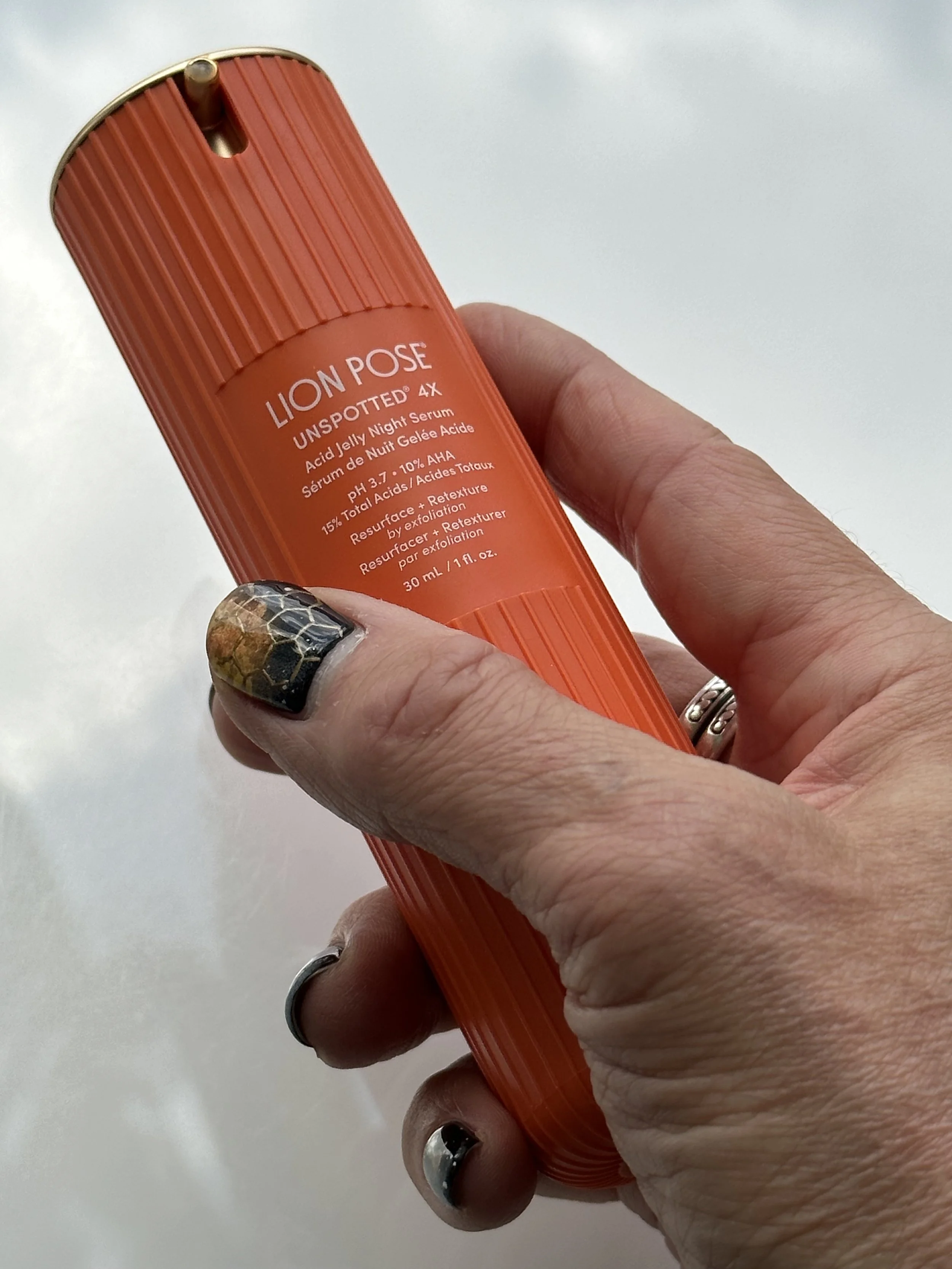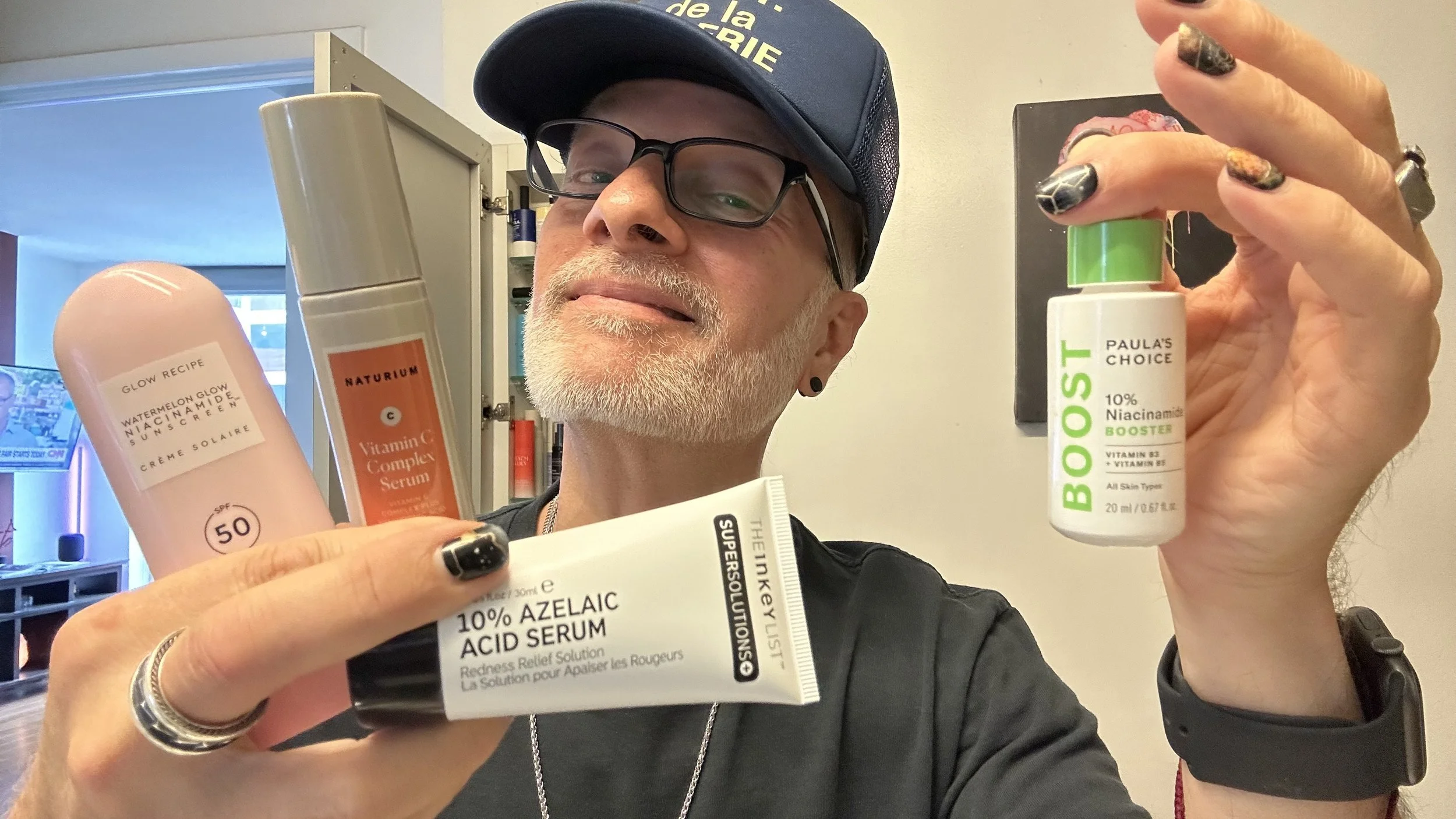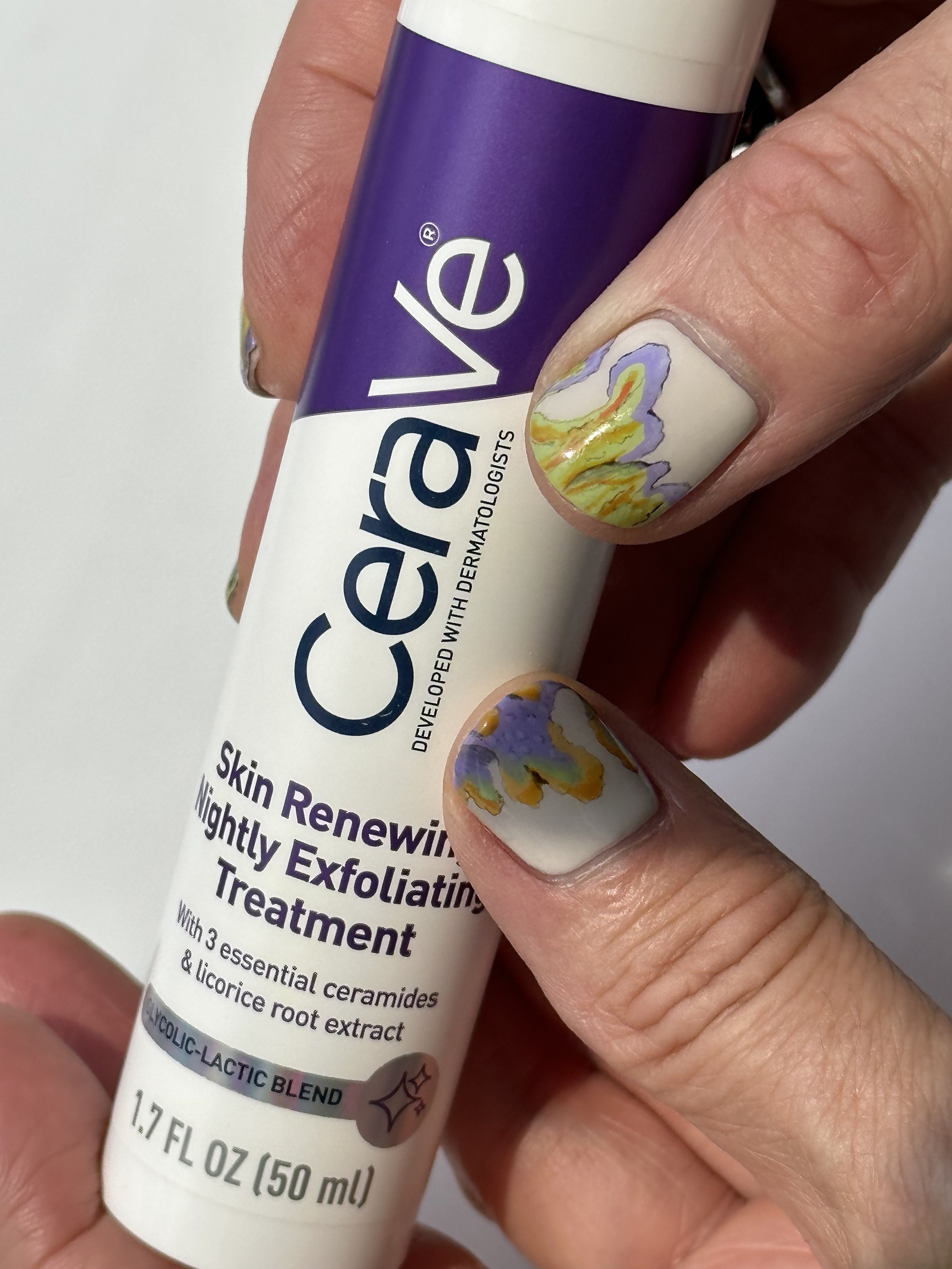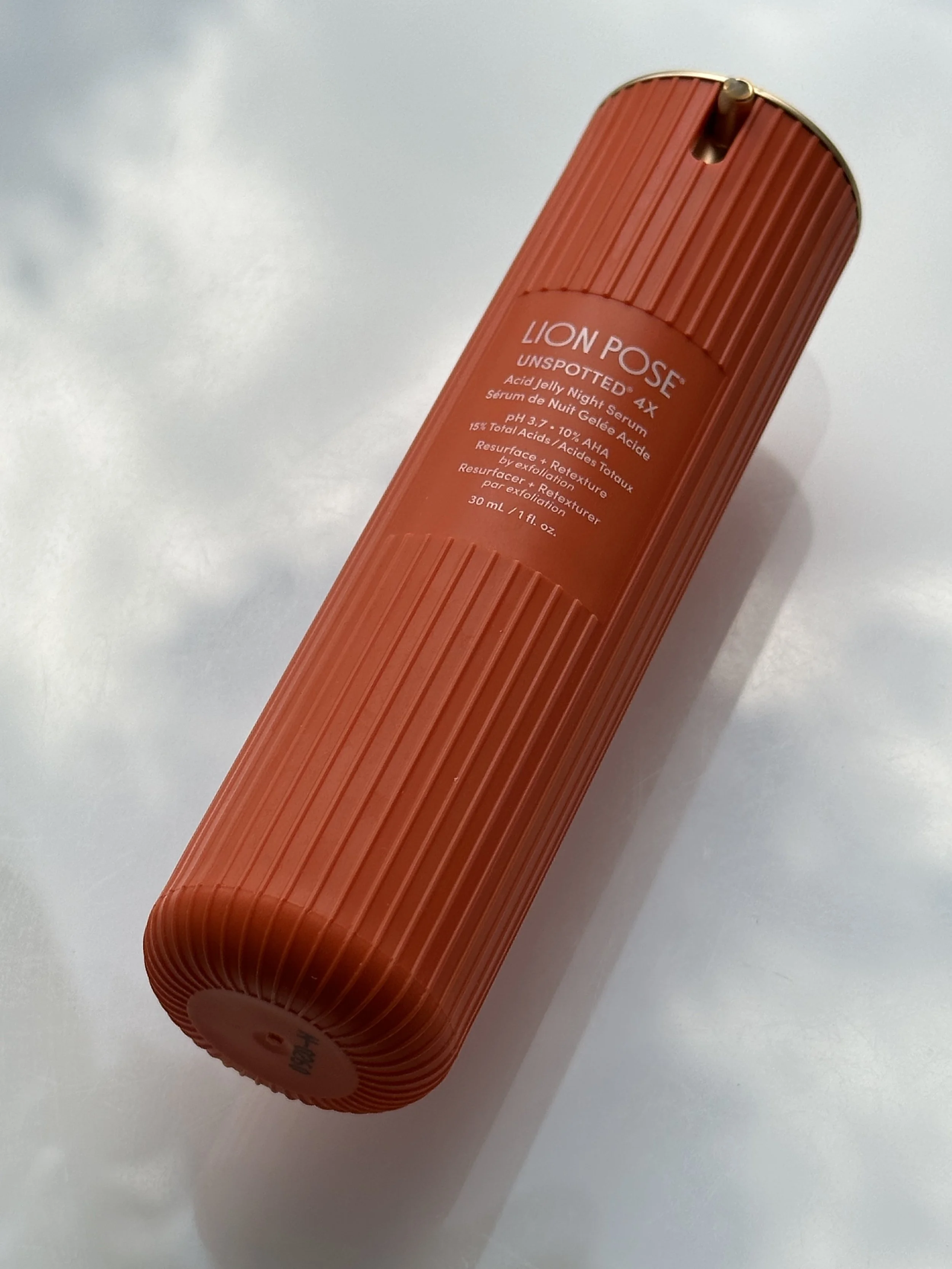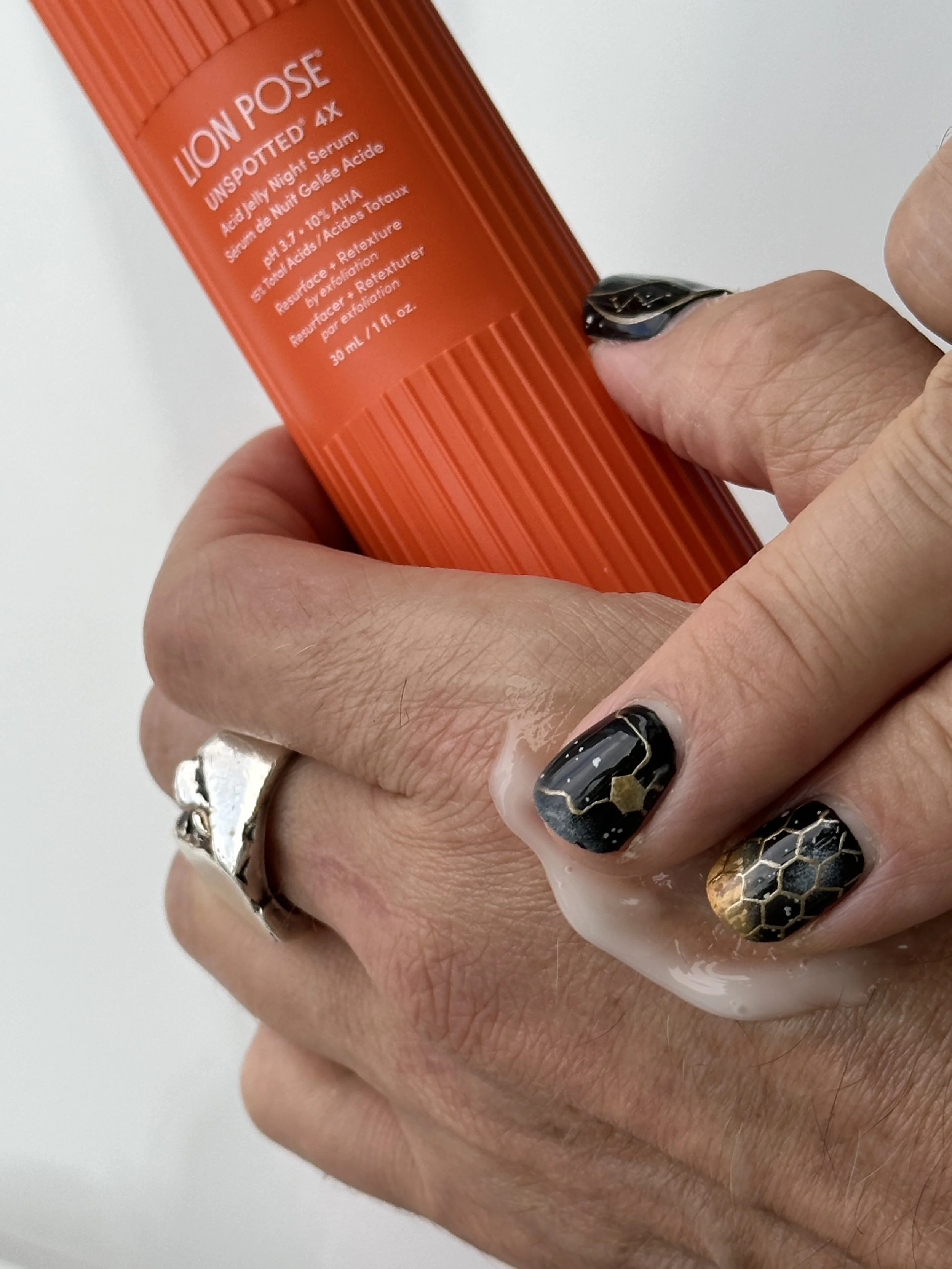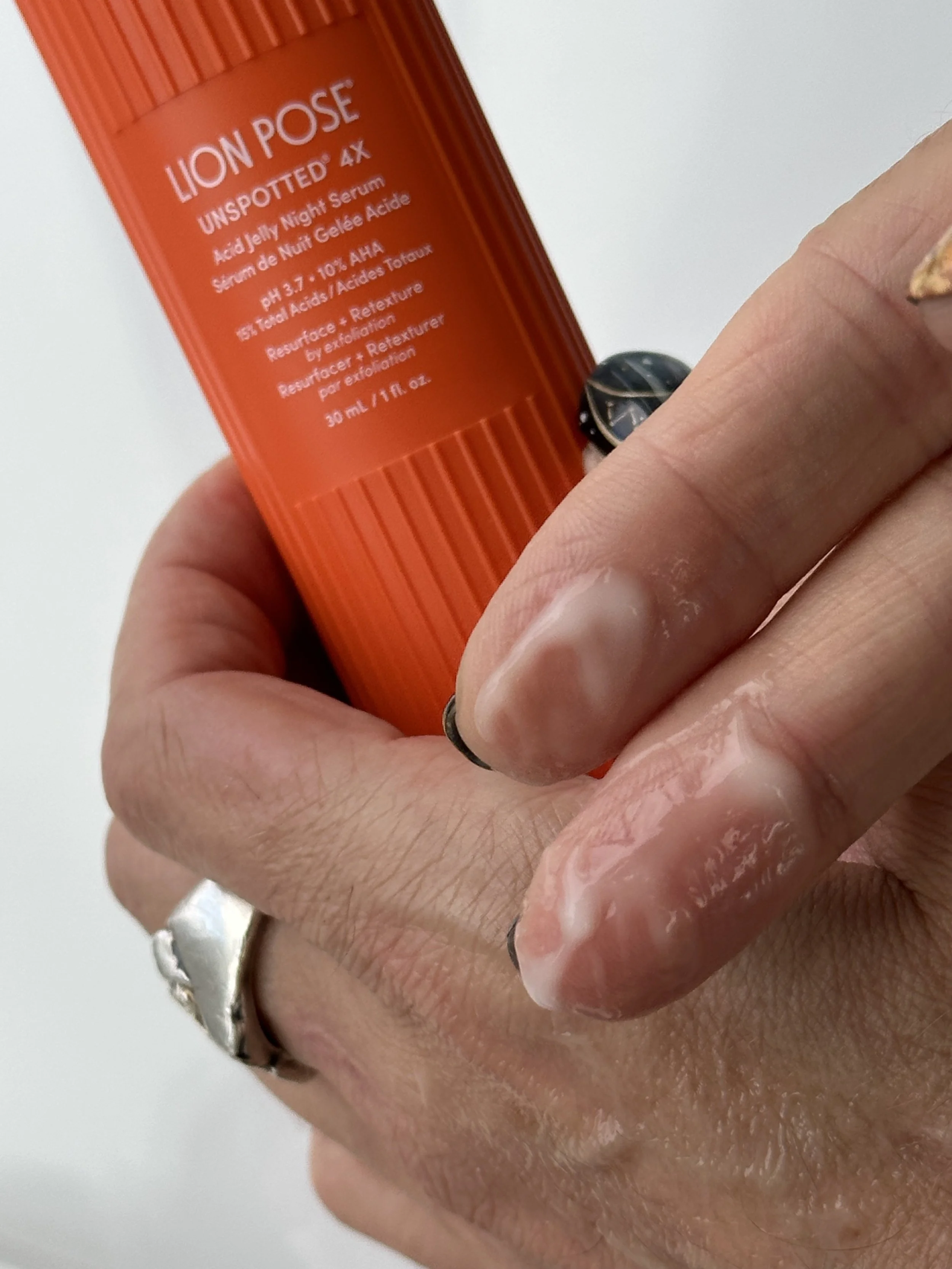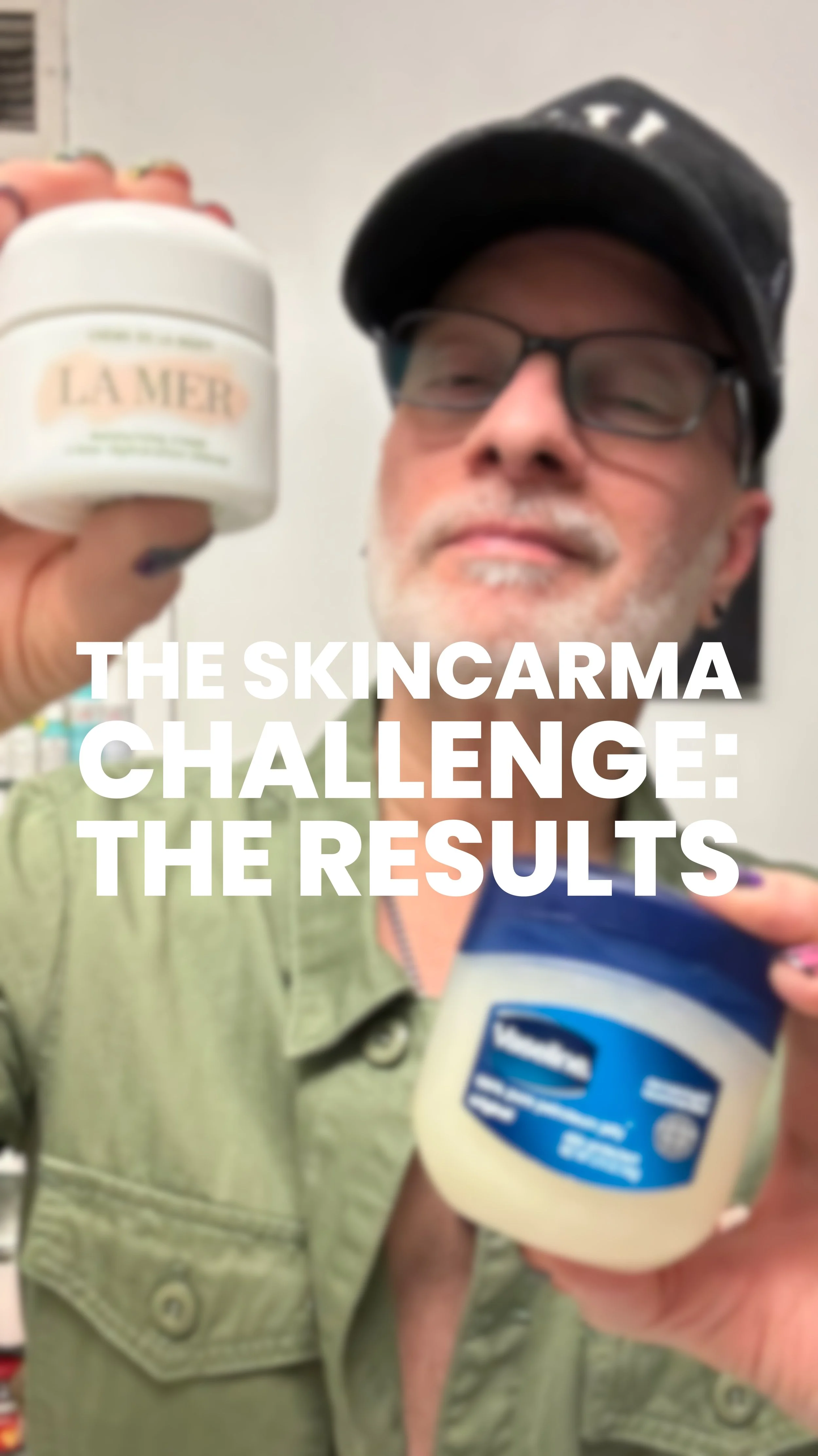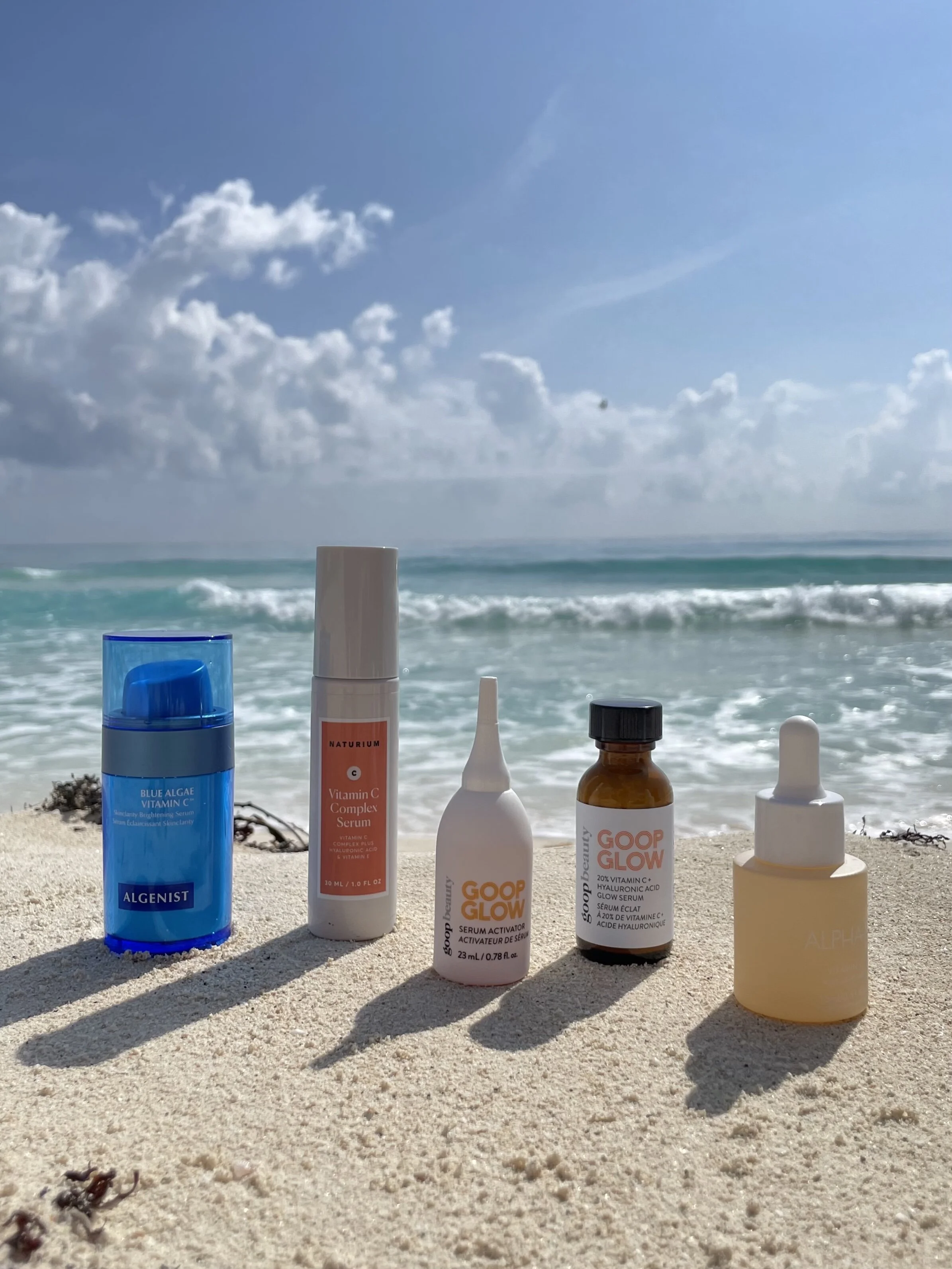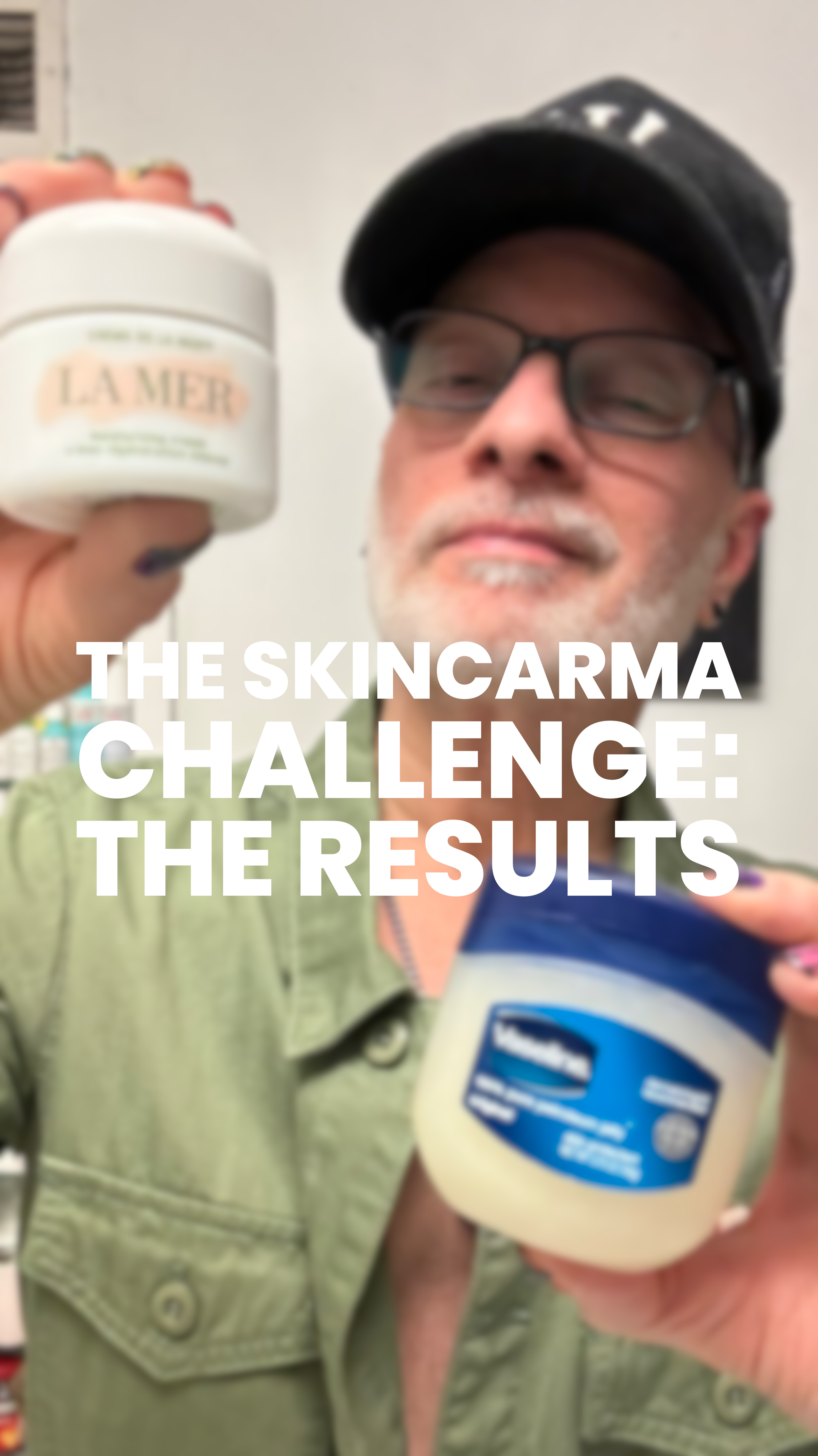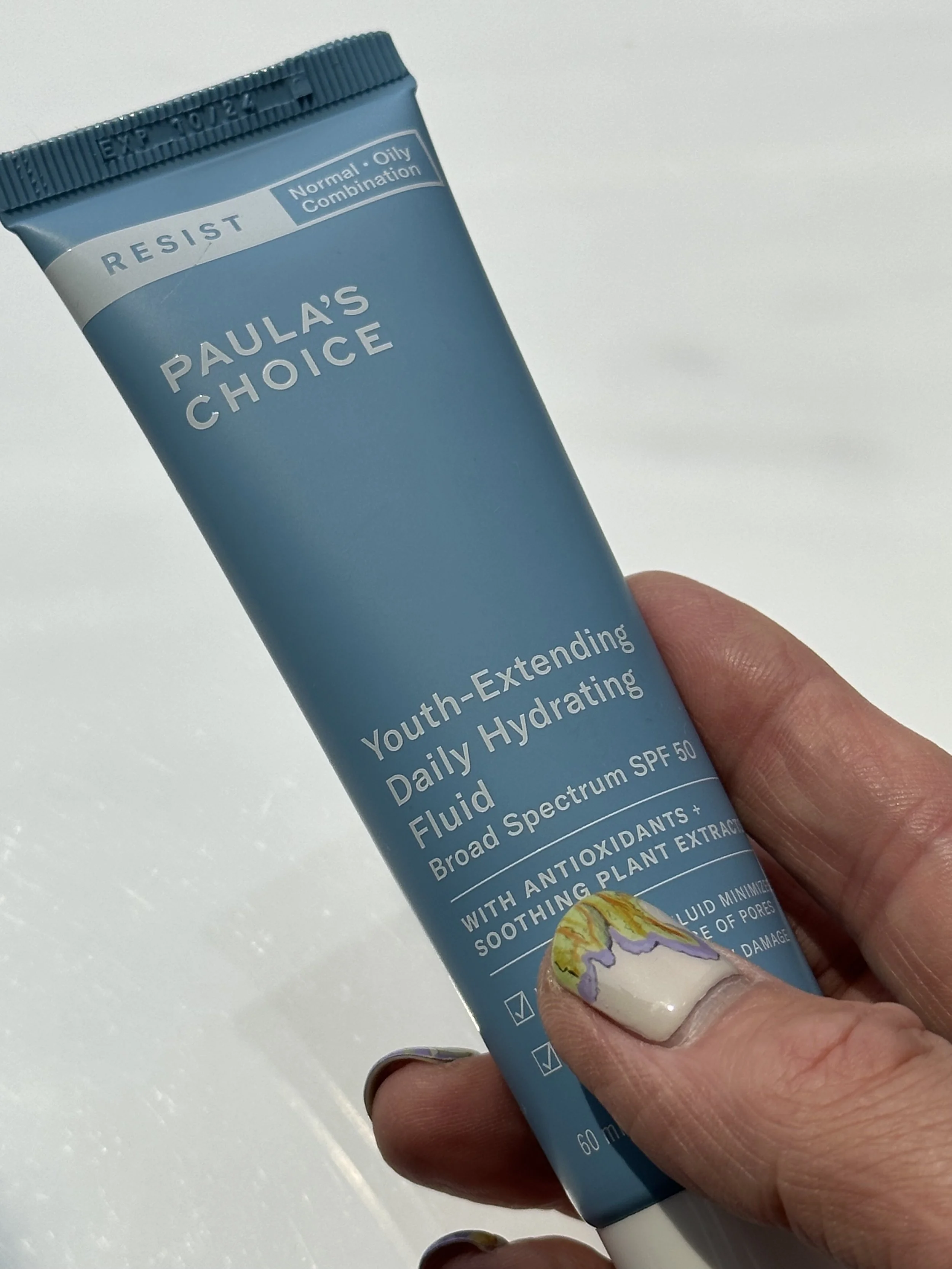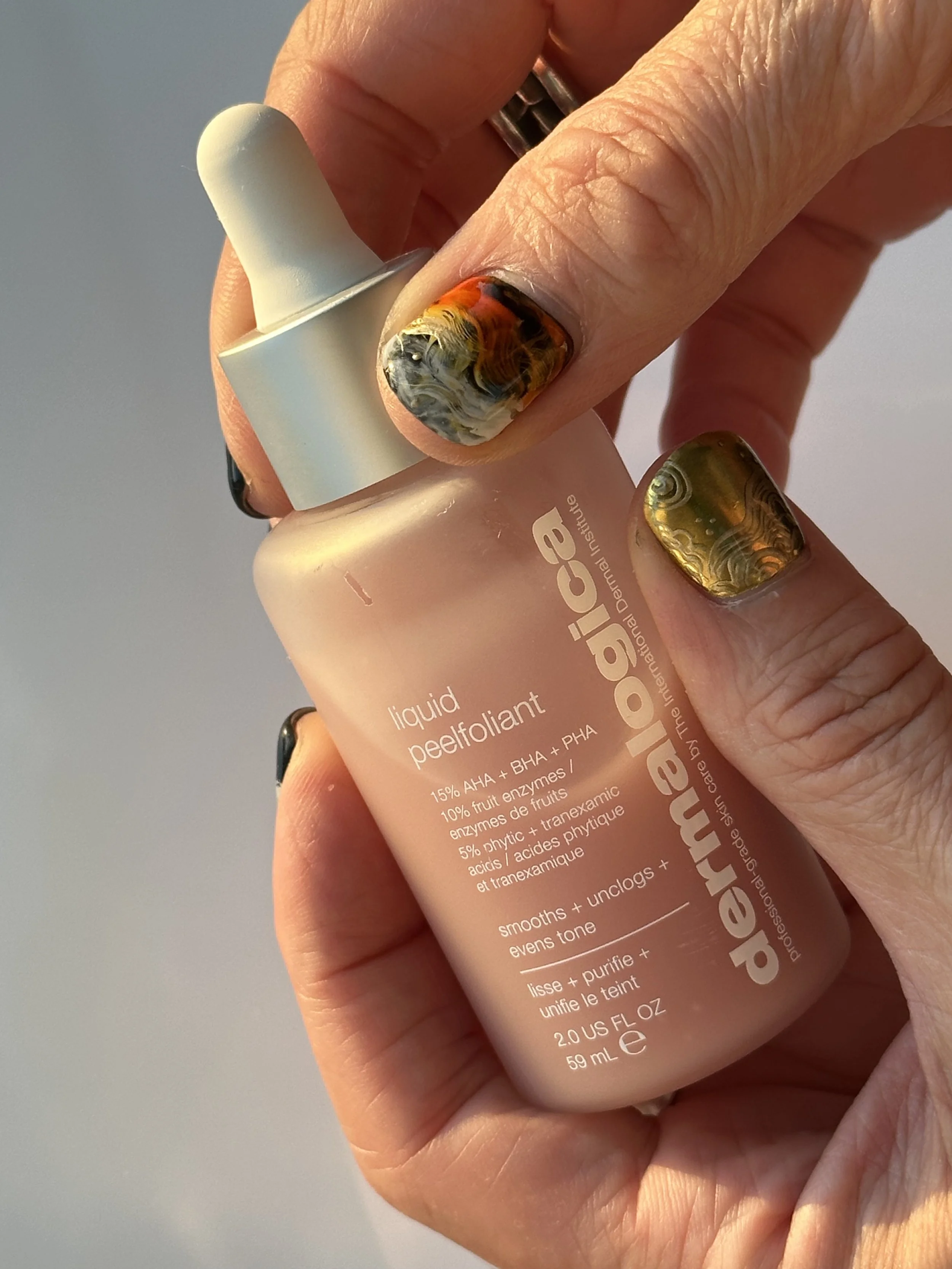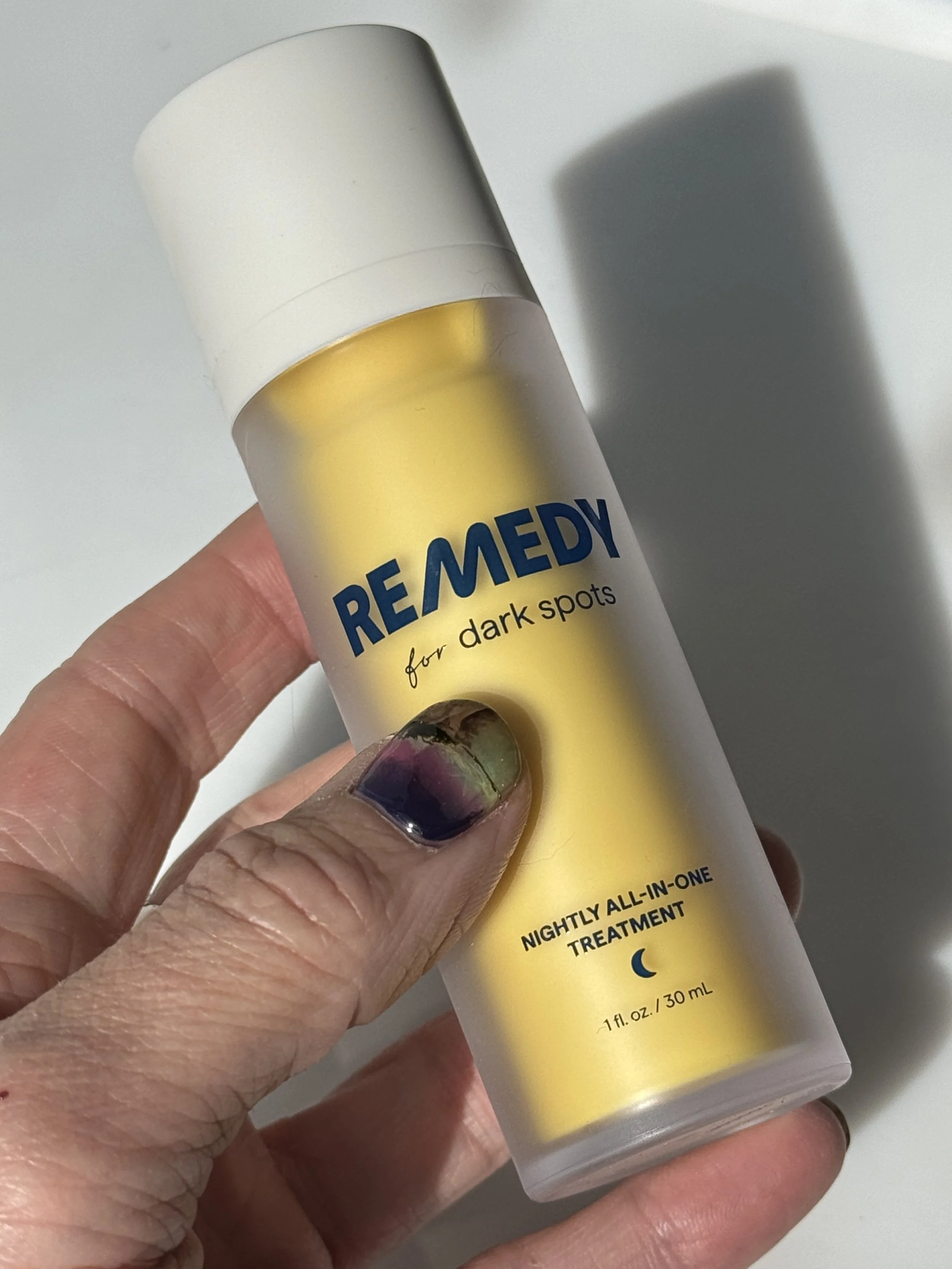PRODUCT REVIEW: LION POSE UNSPOTTED 4X ACID JELLY NIGHT SERUM - How do I get rid of dark spots on my face? What causes hyperpigmentation?
LION POSE UNSPOTTED 4X ACID JELLY NIGHT SERUM
As I’ve often shared, Glycolic Acid face creams and more potent exfoliating treatments with Glycolic Acid kinda scare me. You just never know how strong they are until you try them.
The first time I put on The Ordinary AHA 30% + BHA 2% Exfoliating Peeling Solution, I was terrified. I remember thinking “What’s so ‘ordinary’ about this stuff?!” While I could have easily burned my face off, my survival instincts kicked in and I wiped it off 5 minutes into it – despite the fact that the brand suggests leaving it on for 10 minutes. No, thank you!
I’ve made peace with that product and other popular Glycolic Acid treatments. If you want serious results, you have to use serious actives. And nothing resurfaces and brightens your skin as quickly as AHAs – and Glycolic Acid, in particular. But skincare marketers, formulators and chemists are savvy and often creative; they’re always on the hunt for what’s new and innovative.
It seems like it’s no longer enough to offer AHA exfoliating treatments with just Glycolic and Lactic acids to illuminate the complexion. Recently, a whole slew of brightening actives without exfoliating benefits have come to market. Among these are two very odd-sounding and difficult to spell ingredients: Tranexamic Acid and Azelaic Acid.
Trendy, innovative face serums, creams and targeted treatments with Tranexamic Acid and Azelaic Acid are cropping up everywhere. The marketplace is replete with products like The Inkey List Tranexamic Acid Serum and Naturium’s Azelaic Topical Acid 10%. Both are reviewed on the blog in my collection of the best brightening serums here.
One of these, the most innovative brightening treatment I’ve come across this year, combines brightening and exfoliation: the new Lion Pose Unspotted 4X Acid Jelly Night Serum.
THE BEST BRIGHTENING SERUMS
In fact, Lion Pose’s Unspotted brightening serum is a powerhouse formula with a cocktail of Lactic Acid, Glycolic Acid, Tranexamic Acid and Azelaic Acid – all in the top ten at high concentrations.
I'll get into more detail on the new Lion Pose Unspotted 4X Acid Jelly Night Serum shortly. But first, I think it’s important to understand what alpha-hydroxy acids like Glycolic Acid are and how they differ from a range of new brightening actives, including both Tranexamic Acid and Azelaic Acid.
What are alpha-hydroxy acids like Glycolic Acid?
Well, alpha-hydroxy acids (AHAs) are a group of natural and synthetic acids widely used in skincare for their exfoliating properties. Among these are acids which may be familiar to you: Glycolic Acid, Lactic Acid, Citric Acid and Mandelic Acid. The most potent of the AHAs is Glycolic Acid, which stands out for its unique ability to effectively rejuvenate the skin.
Where does Glycolic Acid come from and what does Glycolic Acid do?
Derived from sugar cane, Glycolic Acid works by gently removing the top layer of dead skin cells, revealing a smoother and brighter complexion by exposing fresher cells below. Its small molecular size allows it to penetrate deeply into the skin, promoting collagen production and aiding in the reduction of fine lines, wrinkles, and hyperpigmentation. It is that deep penetration that makes Glycolic Acid so effective – and so irritating.
Similar to Salicylic Acid, the popular beta-hydroxy acid (BHA) used primarily for treating acne, Glycolic Acid can also help keep pores clear to prevent acne breakouts. With regular use, this potent ingredient can significantly improve overall skin tone and texture, leaving your complexion looking more youthful and radiant.
How often should you exfoliate your face?
NORMAL, BALANCED SKIN: 2x per week
DRY AND SENSITIVE SKIN: 1x per week
OILY, ACNE-PRONE & COMBINATION SKIN: up to 3x per week
Source: Healthline
PRODUCT REVIEW: CERAVE SKIN RENEWING NIGHTLY EXFOLIATING TREATMENT
So while alpha-hydroxy acids like Glycolic and Lactic acids brighten the skin by exfoliating dead surface skin cells, brightening actives like Tranexamic Acid, Azelaic Acid, and even Ascorbic Acid (the pure form of Vitamin C) function in a different way; they are not exfoliating acids.
What is Tranexamic Acid?
Tranexamic Acid has been traditionally used as a medicine for the treatment of bleeding disorders. Derived from the amino acid lysine, the potent active is relatively new in topical skincare. The ingredient is increasingly popular for its ability to address skin concerns like hyperpigmention, skin discoloration and dark spots to promote a brighter, more even and unified complexion.
What does Tranexamic Acid do for skin?
Also known as TXA, Tranexamic Acid possesses superior skin-brightening properties due to its ability to impede melanin production, preventing the formation of dark spots and other forms of hyperpigmentation, including melasma and sun spots, which are visible on the skin’s surface.
Today, Tranexamic Acid is found in some of the best brightening serums, creams and masks, providing a targeted approach to fading dark spots and promoting a radiant, unified skin tone. Incorporating Tranexamic Acid into your skincare routine can be transformative and an easy, effective way to step up your game – and the luminosity of your complexion.
Among my favorite products with Tranexamic Acid are the Topicals Faded Serum For Dark Spots & Discoloration and the Paula’s Choice CLINICAL Discoloration Repair Serum – both of which are reviewed on the blog here.
PRODUCT REVIEW: TOPICALS FADED SERUM FOR DARK SPOTS & DISCOLORATION
What is Azelaic Acid and what does Azelaic Acid do for skin?
Similar to Tranexamic Acid, Azelaic Acid is a powerhouse skin brightener that’s become increasingly popular over the past couple of years. Derived from grains such as wheat and barley, this multitasker has earned a reputation for its versatility and numerous benefits for the skin – particularly oily and acne-prone skins.
Azelaic Acid possesses potent anti-inflammatory and anti-bacterial properties, making it an effective treatment for a broad range of skin concerns. By regulating cell turnover, Azelaic Acid helps to unclog and minimize the look of pores, reducing the appearance of acne and formation of blackheads.
It also helps to even out skin tone by diminishing hyperpigmentation and reducing the redness associated with rosacea and skin irritations. Importantly, Azelaic Acid has antioxidant activity on the skin, protecting it from environmental stressors that contribute to photoaging and other signs of damage.
With its ability to address a wide range of skin issues, including concerns specific to oily and acne-prone skin, the best Azelaic Acid serums and brightening creams with Azelaic Acid have increasingly found their way into daily skincare routines. Among my favorite products with Azelaic Acid are the Paula’s Choice 10% Azelaic Acid Booster and Naturium’s Azelaic Topical Acid 10% – both of which are reviewed on the blog here.
IT’S OKAY TO BE THE VILLAIN SOMETIMES!
Before I get into my detailed Lion Pose Unspotted 4X Acid Jelly Night Serum product review just below, I wanted to answer some of the most frequently asked questions about the causes and solutions for dark spots and hyperpigmentation…
1. How do I get rid of dark spots on my face?
If you're looking to get rid of dark spots on your face, there are a number of treatments and products that can help. Importantly, because effectively treating dark spots and other forms of hyperpigmentation can be challenging, consistency, patience and commitment for the long-term are key.
Here are some effective treatment options for consideration:
Topical treatments: There are a variety of brightening creams and serums for dark spots and hyperpigmentation. These include OTC and prescription creams and serums that are clinically proven to fade dark spots. Look for products that contain ingredients like Hydroquinone, Retinoids, Vitamin C, or Niacinamide as well as newer actives like Tranexamic Acid and Azelaic Acid.
Chemical peels: Chemical peels exfoliate the top layers of skin to reveal the smoother, fresher and brighter skin below. They are a fast, effective solution and can be done at home with broadly available exfoliating serums and masks with Glycolic Acid. For an even stronger chemical treatment, consult with a dermatologist or aesthetician.
Microdermabrasion: Microdermabrasion uses a device to exfoliate the top layers of skin and remove dead skin cells, which can help fade dark spots over time. The best microdermabrasion treatments are available through a dermatologist or aesthetician.
Laser treatments: Laser treatments use focused light to target dark spots and break up pigment in the skin that appears as hyperpigmentation at the surface. Available through a dermatologist or aesthetician, this is a more expensive option, but it can be among the most effective – particularly for embedded dark spots that have been left untreated.
Sun protection: One of the most important things you can do to prevent new dark spots from forming and existing dark spots from becoming more intense, is to protect your skin from sun damage and subsequent photoaging. Wear a broad-spectrum sunscreen with an SPF of 30 or higher every day – even on sunless, seemingly cloudy days.
Explore my top picks of the best sunscreens for face here.
Sources: American Academy of Dermatology (AAD) - How to Get Rid of Dark Spots; Healthline - How to Get Rid of Dark Spots on Your Face
2. What causes hyperpigmentation?
While often difficult to treat, hyperpigmentation is a common skin condition. It is generally characterized by specific areas of skin that appear darker than the surrounding skin. Hyperpigmentation can be caused by a variety of factors, including sun exposure, hormonal changes, and certain medications.
When your skin is exposed to the sun, it produces more melanin as a way of protecting itself from UV damage. Over time, this can lead to areas of hyperpigmentation, including dark spots, sun spots, or melasma.
Hormonal changes during pregnancy or menopause can also trigger the overproduction of melanin, leading to visible hyperpigmentation on the surface of the skin. Certain medications, such as some antibiotics and chemotherapy drugs, can also cause hyperpigmentation as a side effect.
The most effective way to prevent hyperpigmentation resulting from sun exposure is to wear an effective daily facial sunscreen.
Explore my top picks of the best sunscreens for face here.
Sources: American Academy of Dermatology - Hyperpigmentation: Causes and Treatment; Healthline - What You Should Know About Hyperpigmentation
3. What does tranexamic acid do for your face?
Tranexamic Acid is a medication which is most commonly used for the treatment of bleeding disorders; but it has gained popularity in recent years as a topical treatment for hyperpigmentation.
How does Tranexamic Acid work to fade hyperpigmentation?
According to an article on Dovepress, the active has the ability to inhibit the production of melanin, the pigment that gives skin its color.
“It has been demonstrated that tranexamic acid can reverse UV-induced hyperpigmentation. This is because tranexamic acid inhibits the binding of plasminogen to keratinocytes, which in turn reduces the activity of melanocyte tyrosinase, resulting in a decrease in arachidonic acid and prostaglandins. The latter is a well-known inflammatory mediator that leads to melanogenesis, particularly in the face region, which is regarded as a primary contributor to the appearance of aged skin.”
Tranexamic Acid is also believed to have anti-inflammatory properties, which can help to calm and soothe the skin.
Sources: Dovepress - Efficacy and Best Mode of Delivery for Tranexamic Acid in Post-Inflammatory Hyperpigmentation: A Systematic Review; PubMed Central, NIH National Library of Medicine - A Systematic Review of Tranexamic Acid in Plastic Surgery: What’s New?
4. Is tranexamic acid better than Vitamin C?
Tranexamic Acid and Vitamin C, or Ascorbic Acid, are both highly effective when used topically to fade the appearance of hyperpigmentation to unify skin tone and brighten the complexion. The two powerful actives are not mutually exclusive, meaning they can be used together – either in the same brightening serum or the same skincare routine.
While Vitamin C has been featured in topical skincare for nearly two decades, including the best brightening serums and creams, both actives are supported by clinical research.
Some studies have suggested that Tranexamic Acid may be more effective than Vitamin C for treating certain types of hyperpigmentation, such as melasma. However, other studies have found that Vitamin C can be just as effective, if not more so, than Tranexamic Acid for reducing the appearance of dark spots.
An article published by the National Library of Medicine at the NIH, stated the conclusions of a study comparing the efficacy of each: “At the end of 8 weeks, MASI, PGA and PtGA showed improvement with both tranexamic acid and vitamin C. However the improvement was more with tranexamic acid than with vitamin C, although not statistically significant.”
Ultimately, the best treatment for hyperpigmentation will depend on the underlying cause of the pigmentation irregularities and the individual’s unique skin type and concerns.
Sources: Clinikally - Tranexamic Acid for Skin: Benefits, Side Effects & Uses; PubMed Central, NIH National Library of Medicine - A Split Face Comparative Study of Safety and Efficacy of Microneedling with Tranexamic Acid versus Microneedling with Vitamin C in the Treatment of Melasma
5. Product Review
Lion Pose Unspotted 4X Acid Jelly Night Serum Review
Lion Pose seemed to come out of nowhere, emerging on the scene from a dense jungle of skincare products formulated to brighten the complexion. And the brand’s Unspotted 4X Acid Jelly Night Serum is one of the most impressive new brightening serums that I’ve come across.
Which is only more significant given that it’s the brand’s first and only product.
In my recollection, it’s the only brightening serum I’ve seen that combines very high concentrations of Glycolic Acid, Lactic Acid, Azelaic Acid and Tranexamic Acid in the top ten ingredients – a blend that the brand claims to be a combined 15% of the formula.
As I shared at the outset, really potent Glycolic Acid serums give me pause. But at least you usually wash them off – as with The Ordinary’s AHA 30% + BHA 2% Exfoliating Peeling Solution and the Paula’s Choice 25% AHA + 2% BHA Exfoliant Peel. The Lion Pose Unspotted 4X Acid Jelly Night Serum is intended to be used as a leave-on treatment that delivers its brightening oomph while you sleep.
I’m ngl I was really worried the first night I tried it. I had just gotten my hands on Unspotted the same morning and loved its velvety texture. I couldn’t wait. But the INCI was not only impressive, it was alarming. And a leave-on treatment? This could be a recipe for disaster, I remember thinking.
More than a few times, a potent Retinol face serum or Glycolic Acid treatment have sensitized my skin, leaving it red and bumpy in the morning. On more than one occasion it’s been so inflamed that even splashing water on my face hurts.
So at first I intended to just leave Unspotted on for a few minutes to see how my skin would react. That way I could mitigate any sensitization. I carefully smoothed the silky serum over my face, avoiding my eyes. And remarkably, while my skin tingled a little bit, it didn’t become inflamed – or seem irritated in any way.
I hadn’t used any aggressive exfoliating treatments with Glycolic Acid all week so I knew that I wasn’t applying it directly to fresh skin. At least there was a layer of dead surface skin cells to be cleared off! And there was still time to wash it off before bed just in case. Once I was sure I was good, I followed up with a dab of the Skinfix Triple Lipid-Peptide Cream to soothe my skin and seal it in.
THE PERFECT EXFOLIATING CREAM FOR SENSITIVE SKIN
What did I see in the morning? The clearest, brightest and calmest complexion in memory! No joke, I really saw a visible difference in the appearance of my skin. It was more even and healthy looking than it normally would be.
I have to admit, Lion Pose Unspotted 4X Acid Jelly Night Serum is the real thing – a legitimately well-formulated exfoliating and brightening serum in one.
Look, I don’t have existing dark spots or hyperpigmentation to fix. I protect and correct dark spots as part of my daily routine. I use sunscreen religiously and apply a Niacinamide serum and Vitamin C face serum twice daily. And I’ve done this for years. My complexion is relatively unified.
So for me to actually see a visible difference in my complexion is a big deal. And without irritation? That’s not by accident. Unspotted has a solid soothing complex composed of Maranta Arundinacea (Arrow) Root Extract, Hyaluronic Acid, Centella Asiatica Extract, and Aloe Barbadensis Leaf Juice.
The best part is that the results have been replicated over and over again for three weeks now. My skin is always clear, bright and healthy looking the morning after. I’ve even used it on consecutive nights and seen no irritation.
If you’re looking for an effective exfoliating and brightening serum to address complexion irregularities, you may want to give Lion Pose Unspotted 4X Acid Jelly Night Serum a try…
6. Pros & Cons
What I like about it: The Lion Pose Unspotted 4X Acid Jelly Night Serum is one of the most innovative (and coolest!) brightening face serums I’ve come across in a long time. I really appreciate its extensive complex of brightening and exfoliating actives. This is true innovation in a category that is often little more than the same technology spun with sexy marketing campaigns.
What I don’t like about it: I love everything about it.
Who it’s for: All skin types, except very sensitive skins.
SHOP THE BLOG: Want to try it for yourself? Purchase the Lion Pose Unspotted 4X Acid Jelly Night Serum for $79 here.
The Ingredient List of the Lion Pose Unspotted 4X Acid Jelly Night Serum:
Water/Eau/Aqua,Lactic Acid, Aloe Barbadensis Leaf Juice, Glycolic Acid, Maranta Arundinacea Root Extract, Tranexamic Acid, Azelaic Acid, Coconut Alkanes, Hydroxyethyl Acrylate/Sodium Acryloyldimethyl Taurate Copolymer, Polyacrylate Crosspolymer-6, Glutathione, Niacinamide, Sodium Hyaluronate, Centella Asiatica Extract, Leuconostoc/Radish Root Ferment Filtrate, Prunus Domestica Fruit Extract, Orchis Mascula Flower Extract, Glycerin, Coco-Caprylate/Caprate, Caprylyl Glycol, Hexylene Glycol, Pentylene Glycol, 1,2-Hexanediol, Sodium Hydroxide, Sodium Benzoate, Phenoxyethanol, Ethylhexylglycerin.
IS IT REALLY A SCAM?
Find out on my TikTok channel.
MY TOP VITAMIN C PICKS: VITAMIN C SERUMS I’M CRUSHING ON FROM ALGENIST, NATURIUM AND MORE
WATCH MY VIDEO REVIEW
THE BEST NIACINAMIDE SERUMS FOR CLOGGED PORES AND A BRIGHTER COMPLEXION
ON MY YOUTUBE CHANNEL HERE
WATCH MY VIDEO REVIEW OF
SKINCARE HACKS: GLYCOLIC ACID IS THE NATURAL DEODORANT THAT WORKS!
ON MY YOUTUBE CHANNEL HERE
WATCH MY VIDEO REVIEW OF
MY FAVORITE HUMECTANT SERUMS FROM PAULA'S CHOICE, THE INKEY LIST, GHOST DEMOCRACY AND MORE
ON MY YOUTUBE CHANNEL HERE
WATCH MY VIDEO REVIEW
COOL CLEAN FACIAL SUNSCREENS TO KEEP US SAFE AND SMILING IN THE SUN!
ON MY YOUTUBE CHANNEL HERE
WATCH MY VIDEO REVIEW
THE OPULUS BEAUTY LABS RETINOL SYSTEM – THE COOLEST RETINOL INNOVATION I’VE EVER SEEN
ON MY YOUTUBE CHANNEL HERE
WATCH MY VIDEO REVIEW
MY 2021 VITAMIN C PICKS + THE BEST VITAMIN C SERUMS TO BRIGHTEN UP THE COMPLEXION!
ON MY YOUTUBE CHANNEL HERE
WATCH MY VIDEO REVIEW OF
MY WINTER SKIN SAVIOR: SKINFIX BARRIER+ LIPID REPLENISHING SKINCARE
ON MY YOUTUBE CHANNEL HERE
WATCH MY VIDEO REVIEW
A COMPLETE K-BEAUTY ROUTINE WITH THE BEST FACIAL SKINCARE FROM PURITO, COSRX, MISSHA & MORE!
ON MY YOUTUBE CHANNEL HERE
WATCH MY VIDEO REVIEW
THE YEAR’S BEST VITAMIN C SERUMS WITH PAULA'S CHOICE, SUNDAY RILEY, THE INKEY LIST AND MORE!
ON MY YOUTUBE CHANNEL HERE
WATCH MY VIDEO REVIEW OF
A SELFCARE SUNDAY NOT FOR THE FAINT OF HEART – WITH THE PAULA’S CHOICE 25% AHA PEEL!
ON MY YOUTUBE CHANNEL HERE


